THEME: FIGURATIVE
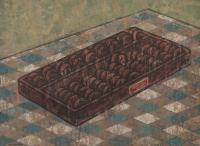 He Jian is notable for his amalgamation of ancient and contemporary Chinese culture. Rather than painting in oil like most of his contemporaries, he uses rice paper, dry pigment, and binder as his media. He strategically layers and manipulates his paints to take on the timeworn quality of the 14th century Yuan Dynasty frescoes at the Yong Le Temple in Shanxi Province. He Jian uses this distinctive new-old, antiquated style to present a wide range of quotidian subject matter. Although many of his works portray figural groups engaged in activities characteristic of modern Chinese life, in this series He Jian directs his focus towards utilitarian objects that signaled China’s shift towards a consumer culture. The cheap electronics that have dominated Chinese manufacturing in the past two decades have all but obliterated use of the abacus, a traditional Asian counting tool. But it was only as recently as the 1990s when virtually every shopkeeper in the mainland used one. In a short span of time, the abacus has already become a forgotten object, and both He Jian's stylistics and subject matter are informed by this nostalgia.
He Jian is notable for his amalgamation of ancient and contemporary Chinese culture. Rather than painting in oil like most of his contemporaries, he uses rice paper, dry pigment, and binder as his media. He strategically layers and manipulates his paints to take on the timeworn quality of the 14th century Yuan Dynasty frescoes at the Yong Le Temple in Shanxi Province. He Jian uses this distinctive new-old, antiquated style to present a wide range of quotidian subject matter. Although many of his works portray figural groups engaged in activities characteristic of modern Chinese life, in this series He Jian directs his focus towards utilitarian objects that signaled China’s shift towards a consumer culture. The cheap electronics that have dominated Chinese manufacturing in the past two decades have all but obliterated use of the abacus, a traditional Asian counting tool. But it was only as recently as the 1990s when virtually every shopkeeper in the mainland used one. In a short span of time, the abacus has already become a forgotten object, and both He Jian's stylistics and subject matter are informed by this nostalgia.
Click on the artwork for more information-
$35.00
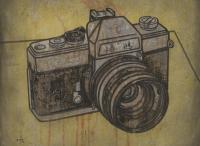 He Jian is notable for his distinctive amalgamation of ancient and contemporary Chinese culture. Rather than painting in oil like most of his contemporaries, he uses rice paper, dry pigment, and binder as his media. He strategically layers and manipulates his paints to take on the timeworn quality of the 14th century Yuan Dynasty frescoes at the Yong Le Temple in Shanxi Province. He Jian uses this distinctive new-old, antiquated style to present a wide range of quotidian subject matter. Although many of his works portray figural groups engaged in activities characteristic of modern Chinese life, in this series He Jian directs his focus towards utilitarian objects that signaled China’s shift towards a consumer culture. Seagull, the first camera maker in China founded in 1958, released the DF series seen here in 1964, and today, its image instantly conjures nostalgia for the time period. He Jian's painting melds the stylistics of classical China with a subject that heralds its recent history in paintings that negotiate the separate but continuous histories that inform China's present.
He Jian is notable for his distinctive amalgamation of ancient and contemporary Chinese culture. Rather than painting in oil like most of his contemporaries, he uses rice paper, dry pigment, and binder as his media. He strategically layers and manipulates his paints to take on the timeworn quality of the 14th century Yuan Dynasty frescoes at the Yong Le Temple in Shanxi Province. He Jian uses this distinctive new-old, antiquated style to present a wide range of quotidian subject matter. Although many of his works portray figural groups engaged in activities characteristic of modern Chinese life, in this series He Jian directs his focus towards utilitarian objects that signaled China’s shift towards a consumer culture. Seagull, the first camera maker in China founded in 1958, released the DF series seen here in 1964, and today, its image instantly conjures nostalgia for the time period. He Jian's painting melds the stylistics of classical China with a subject that heralds its recent history in paintings that negotiate the separate but continuous histories that inform China's present.
Click on the artwork for more information-
$35.00
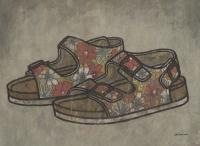 Artist He Jian is notable for his amalgamation of ancient and contemporary Chinese culture. Rather than painting in oil like most of his contemporaries, He Jian uses rice paper, dry pigment, and binder as his media. He strategically layers and manipulates his paints to take on the timeworn quality of the 14th century Yuan Dynasty frescoes at the Yong Le Temple in Shanxi Province. He Jian uses this distinctive new-old, antiquated style to present a wide range of quotidian subject matter. Although many of his works portray figural groups engaged in activities characteristic of contemporary Chinese life, in this series He Jian directs his focus towards utilitarian objects that signal China’s shift towards a consumer culture. In this painting, He Jian depicts a pair of floral sandals. The anachronistic depiction of this footwear suggests its elevation to the same level as the Taoist deities that line the walls of Yong Le Temple. He Jian's painting melds the style and flavor of ancient China with a subject that heralds its recent history, visualizing the complex dialogue between ancient and contemporary Chinese culture.
Artist He Jian is notable for his amalgamation of ancient and contemporary Chinese culture. Rather than painting in oil like most of his contemporaries, He Jian uses rice paper, dry pigment, and binder as his media. He strategically layers and manipulates his paints to take on the timeworn quality of the 14th century Yuan Dynasty frescoes at the Yong Le Temple in Shanxi Province. He Jian uses this distinctive new-old, antiquated style to present a wide range of quotidian subject matter. Although many of his works portray figural groups engaged in activities characteristic of contemporary Chinese life, in this series He Jian directs his focus towards utilitarian objects that signal China’s shift towards a consumer culture. In this painting, He Jian depicts a pair of floral sandals. The anachronistic depiction of this footwear suggests its elevation to the same level as the Taoist deities that line the walls of Yong Le Temple. He Jian's painting melds the style and flavor of ancient China with a subject that heralds its recent history, visualizing the complex dialogue between ancient and contemporary Chinese culture.
Click on the artwork for more information-
$35.00
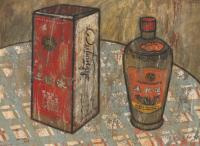 He Jian is notable for his distinctive amalgamation of ancient and contemporary Chinese culture. Rather than painting in oil like most of his contemporaries, he uses rice paper, dry pigment, and binder as his media. He strategically layers and manipulates his paints to assume the timeworn quality of the 14th century Yuan Dynasty frescoes at the Yong Le Temple in Shanxi Province. He Jian uses this distinctive new-old, antiquated style to present a wide range of quotidian subject matter. Although many of his works portray figural groups engaged in activities characteristic of modern Chinese life, in this series He Jian directs his focus towards utilitarian objects that signaled China’s shift towards a consumer culture.
He Jian is notable for his distinctive amalgamation of ancient and contemporary Chinese culture. Rather than painting in oil like most of his contemporaries, he uses rice paper, dry pigment, and binder as his media. He strategically layers and manipulates his paints to assume the timeworn quality of the 14th century Yuan Dynasty frescoes at the Yong Le Temple in Shanxi Province. He Jian uses this distinctive new-old, antiquated style to present a wide range of quotidian subject matter. Although many of his works portray figural groups engaged in activities characteristic of modern Chinese life, in this series He Jian directs his focus towards utilitarian objects that signaled China’s shift towards a consumer culture.
In this painting, He Jian takes the most renowned brand of Chinese grain liquor, Wuliangye, as his subject. Made from a five-crop blend (broomcorn, rice, glutinous rice, wheat, and corn), Wuliangye is known within every household in China but not without, where the stiff liquor has yet to win over drinkers. The liquor in He Jian's painting is depicted with a nostalgic touch, and Wuliangye is a heritage brand as much a part of China's lived history as anything in history books.
Click on the artwork for more information-
$35.00
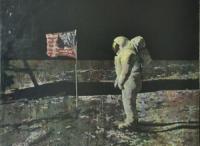 Chen Shijun's distinctive painting style mediates between digital and physical images. The Online Encyclopedia series, for example, takes prosaic images found while browsing online as its source material, and then interprets it through through heavy texturing and a nostalgic palette, converting the raw digital image into a final product with an exceptional sense of physicality. Online Encyclopedia: True Facts No. 2 takes as its source a digital photograph of man's 1960s landing on the moon. The photograph bears the watermark of Xinhua, the official news agency of the Chinese government. Chen Shijun highlights the conflict between battling narratives from the United States, responsible for the landing, and Xinhua, responsible for narrating the story to a Chinese audience. The title of the work, True Facts (2) is a question asking what is reality, how is it represented, and who tells it?
Chen Shijun's distinctive painting style mediates between digital and physical images. The Online Encyclopedia series, for example, takes prosaic images found while browsing online as its source material, and then interprets it through through heavy texturing and a nostalgic palette, converting the raw digital image into a final product with an exceptional sense of physicality. Online Encyclopedia: True Facts No. 2 takes as its source a digital photograph of man's 1960s landing on the moon. The photograph bears the watermark of Xinhua, the official news agency of the Chinese government. Chen Shijun highlights the conflict between battling narratives from the United States, responsible for the landing, and Xinhua, responsible for narrating the story to a Chinese audience. The title of the work, True Facts (2) is a question asking what is reality, how is it represented, and who tells it?
Click on the artwork for more information-
$35.00
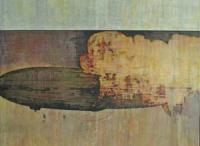 Chen Shijun's distinctive painting style mediates between digital and physical images. The Online Encyclopedia series, for example, takes prosaic images found while browsing online as its source material, and then interprets it through through heavy texturing and a nostalgic palette, converting the raw digital image into a final product with an exceptional sense of physicality. Online Encyclopedia: Disaster, takes as its source material a screen capture of an image search result on a Chinese search machine, showing the iconic photograph of the Hindenberg burning in mid-air. The famous photograph has become ubiquitous, popping up in searches for the word “disaster,” and here Chen Shijun gives the photograph a sense of its age by instilling the painting with rich texture and wear.
Chen Shijun's distinctive painting style mediates between digital and physical images. The Online Encyclopedia series, for example, takes prosaic images found while browsing online as its source material, and then interprets it through through heavy texturing and a nostalgic palette, converting the raw digital image into a final product with an exceptional sense of physicality. Online Encyclopedia: Disaster, takes as its source material a screen capture of an image search result on a Chinese search machine, showing the iconic photograph of the Hindenberg burning in mid-air. The famous photograph has become ubiquitous, popping up in searches for the word “disaster,” and here Chen Shijun gives the photograph a sense of its age by instilling the painting with rich texture and wear.
Click on the artwork for more information-
$35.00
 Huang Yuncan’s series New Youth, looks at the transience of youth and the delicate memories it creates. Huang mimics the haziness of recollection with floating spots that coalesce into figures and interactions.
Huang Yuncan’s series New Youth, looks at the transience of youth and the delicate memories it creates. Huang mimics the haziness of recollection with floating spots that coalesce into figures and interactions.
Two women with puckered lips approach one another with awkwardly bent knees and wrists. Their affected air kissing belies a system of social interaction borrowed from elsewhere—are these kisses of greeting, parting, or have they taken on a completely new meaning? In contrast with their parents generation, these members of China’s urban youth sport the latest fashions, Chuck Taylors and sunglasses. With the exception of the women’s flushed faces, the only other items that receive special notice are the purple gloves and red coat, bringing focus to material possessions. Within the mind’s unreliable archives, a superficial detail can come to define a moment.
This moment seems contemporary, but Huang presents it as a memory, begging the question of what the future holds for this generation and its hybrid culture, and more importantly, what it will be remembered for.
Click on the artwork for more information-
$35.00
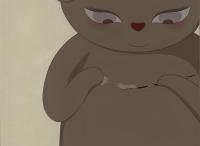 As the title of the work implies, this teddy bear with a heart-shaped nose and a coy smile appears to be quite peaceful. Upon closer examination, however, a more sinister and disturbing scene unfolds before us. We quickly discover that this cuddly creature is in the midst of pulling the stuffing from its chest. Even more unsettling is the apparent relish with which this act is being undertaken. The bear's focused gaze, rosy cheeks and sly grin all illustrate a degree of amusement. An additional level of tension and disquiet is achieved with the subtle drops of ruby red along the mouth and dotting its paws. This detail further emphasizes the surreal elements of the composition, as this seemingly living, breathing stuffed bear blushes with pleasure.
As the title of the work implies, this teddy bear with a heart-shaped nose and a coy smile appears to be quite peaceful. Upon closer examination, however, a more sinister and disturbing scene unfolds before us. We quickly discover that this cuddly creature is in the midst of pulling the stuffing from its chest. Even more unsettling is the apparent relish with which this act is being undertaken. The bear's focused gaze, rosy cheeks and sly grin all illustrate a degree of amusement. An additional level of tension and disquiet is achieved with the subtle drops of ruby red along the mouth and dotting its paws. This detail further emphasizes the surreal elements of the composition, as this seemingly living, breathing stuffed bear blushes with pleasure.
Click on the artwork for more information-
$35.00
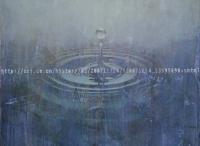 Chen Shijun's distinctive painting style mediates between digital and physical images. The Online Encyclopedia series, for example, takes prosaic images found while browsing online as its source material, and then interprets it through through heavy texturing and a nostalgic palette, converting the raw digital image into a final product with an exceptional sense of physicality. Online Encyclopedia: Obsessive-Compulsive Disorder, takes an image of a water droplet and its ripples, the sort of commercial photograph that comes preinstalled as a background image on many computers, as its point of departure. The perfect unbroken color fields of the original become wrinkled and worn, while an overlaid http address suggests a sense of artificiality.
Chen Shijun's distinctive painting style mediates between digital and physical images. The Online Encyclopedia series, for example, takes prosaic images found while browsing online as its source material, and then interprets it through through heavy texturing and a nostalgic palette, converting the raw digital image into a final product with an exceptional sense of physicality. Online Encyclopedia: Obsessive-Compulsive Disorder, takes an image of a water droplet and its ripples, the sort of commercial photograph that comes preinstalled as a background image on many computers, as its point of departure. The perfect unbroken color fields of the original become wrinkled and worn, while an overlaid http address suggests a sense of artificiality.
Click on the artwork for more information-
$35.00
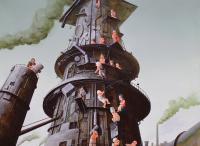 Zhu Zhiwei’s paintings dwell on the incredible scale of China’s industrialization, and the relationship between modern city-dwellers and the man-made environment that they inhabit. In Paradise—Chasing the Wind, factories obscure the horizon. The elongated format and multiple, skewed perspectives of create an intentionally disorienting, fantastical setting. The large central tower seems to be falling apart while it is swarmed by Zhu’s distinctive pink figures. Wearing sunglasses, they climb, dangle and perch on the tower’s nonsensical railings and ledges, creating the impression of an industrial playground. A few characters appear in heroic poses - climbing, carrying objects or helping each other scale the structure. Some sit idly, while others busy themselves pulling pieces off the tower or casting debris downwards. The painting’s lone woman, wearing a qipao (a traditional Chinese dress), dangles her heels, while two men engage in a fistfight down below. On the higher platforms several people. including a man in a red cape, look off into the distance. All appear to be oblivious to rickety state of the tower.
Zhu Zhiwei’s paintings dwell on the incredible scale of China’s industrialization, and the relationship between modern city-dwellers and the man-made environment that they inhabit. In Paradise—Chasing the Wind, factories obscure the horizon. The elongated format and multiple, skewed perspectives of create an intentionally disorienting, fantastical setting. The large central tower seems to be falling apart while it is swarmed by Zhu’s distinctive pink figures. Wearing sunglasses, they climb, dangle and perch on the tower’s nonsensical railings and ledges, creating the impression of an industrial playground. A few characters appear in heroic poses - climbing, carrying objects or helping each other scale the structure. Some sit idly, while others busy themselves pulling pieces off the tower or casting debris downwards. The painting’s lone woman, wearing a qipao (a traditional Chinese dress), dangles her heels, while two men engage in a fistfight down below. On the higher platforms several people. including a man in a red cape, look off into the distance. All appear to be oblivious to rickety state of the tower.
Amidst this flurry of activity, the tower’s purpose remains unclear; the top disappears into a dark, hazy cloud of smoke that drifts across the upper left-hand corner of the composition. The painting’s low vantage point and the strong diagonal lines formed by the tubes on either side of the tower create a disorienting perspective. Viewing the tower from its base, we too can contemplate climbing its dislocated staircases.
Click on the artwork for more information-
$35.00
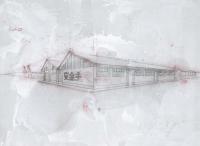 Chen Jiao's November 7th is named after a date, but features an industrial building, sketched lightly against a square grid. More than the building itself, its form stands out against the blank background, with perspective points and the foreground's boundary clearly visible. Against the front building's side, a slogan is available: “safe production,” painted in bold red characters. The final two characters are each drawn backwards, giving a clue that this is image is not actually meant to be a precise rendering of an actual structure. The markings of light color washes are visible in the background, and the work is dotted with Chen's calculations, leaving building measurements and calculations visible. But Chen is no architect. Trained in oil paiting at the Sichuan Fine Art Institute, Chen leaves the calculations visible as a means of voicing the utility and design that goes into the sketch, asking which meanings remain when the building is described in only its signs.
Chen Jiao's November 7th is named after a date, but features an industrial building, sketched lightly against a square grid. More than the building itself, its form stands out against the blank background, with perspective points and the foreground's boundary clearly visible. Against the front building's side, a slogan is available: “safe production,” painted in bold red characters. The final two characters are each drawn backwards, giving a clue that this is image is not actually meant to be a precise rendering of an actual structure. The markings of light color washes are visible in the background, and the work is dotted with Chen's calculations, leaving building measurements and calculations visible. But Chen is no architect. Trained in oil paiting at the Sichuan Fine Art Institute, Chen leaves the calculations visible as a means of voicing the utility and design that goes into the sketch, asking which meanings remain when the building is described in only its signs.
Click on the artwork for more information-
$35.00
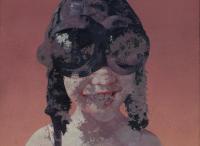 A toothy grin and great googly eyes. A child smiles at you, and the aviator's cap on her head is both absurd and whimsical, a joke the child knowingly shares with you the observer. Children are a frequent theme in Guo Jin's work, meditations upon pure joy and unadultered idealism. But against the context of modern China, the commentary takes on deeper, critical tones, asking if society's innocence has been lost or if naivety remains; if our worldview is youthful with its eyes full of opportunity, or blinded and obscurded by play-acting and make-believe.
A toothy grin and great googly eyes. A child smiles at you, and the aviator's cap on her head is both absurd and whimsical, a joke the child knowingly shares with you the observer. Children are a frequent theme in Guo Jin's work, meditations upon pure joy and unadultered idealism. But against the context of modern China, the commentary takes on deeper, critical tones, asking if society's innocence has been lost or if naivety remains; if our worldview is youthful with its eyes full of opportunity, or blinded and obscurded by play-acting and make-believe.
Click on the artwork for more information-
$35.00
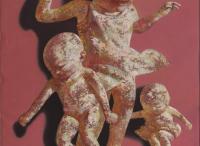 Children are a frequent theme in Guo Jin's work, meditations upon pure joy and unadultered idealism. Jumping catches three children at Henri Cartier-Bresson's “decisive moment,” poised in kinetic potential as they jump mid-air against an abstract pink sky. Their rounded bodies possess a convincing heft, but their skin is spackled in red, yellow, peach, and white, a texture that suggests both materiality, like the surface of marble, and the passage of time, like antiqued painted furniture. Are these children real or allegorical? Where are they leaping to and what are they leaping from? Guo Jin's work gives itself to many different readings, but the children's sense of dynamism and joy remains constant.
Children are a frequent theme in Guo Jin's work, meditations upon pure joy and unadultered idealism. Jumping catches three children at Henri Cartier-Bresson's “decisive moment,” poised in kinetic potential as they jump mid-air against an abstract pink sky. Their rounded bodies possess a convincing heft, but their skin is spackled in red, yellow, peach, and white, a texture that suggests both materiality, like the surface of marble, and the passage of time, like antiqued painted furniture. Are these children real or allegorical? Where are they leaping to and what are they leaping from? Guo Jin's work gives itself to many different readings, but the children's sense of dynamism and joy remains constant.
Click on the artwork for more information-
$35.00
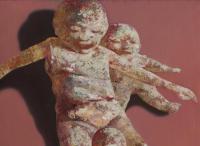 Children are a frequent theme in Guo Jin's work, meditations upon pure joy and unadultered idealism. Sliding captures a group of three moving with grace and abandon down an unseen slide behind them. Their movement is innocent, capturing a moment of play, but when the children are considered as stand-ins for something greater, whether that be society or the state of a country, the painting takes on greater complexities: does the downward slide imply loss or danger, and if so, what is the childrens' agency? Did they initate this descent, or plunge into it unwittingly? Guo Jin's work gives itself to many different readings, but the painting's sense of momentum and unknown potential remains constant.
Children are a frequent theme in Guo Jin's work, meditations upon pure joy and unadultered idealism. Sliding captures a group of three moving with grace and abandon down an unseen slide behind them. Their movement is innocent, capturing a moment of play, but when the children are considered as stand-ins for something greater, whether that be society or the state of a country, the painting takes on greater complexities: does the downward slide imply loss or danger, and if so, what is the childrens' agency? Did they initate this descent, or plunge into it unwittingly? Guo Jin's work gives itself to many different readings, but the painting's sense of momentum and unknown potential remains constant.
Click on the artwork for more information-
$35.00
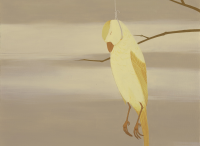 Disquieting in both its graphic content and perverse visual appeal, this work provides the conflicting experience of drawing you in while turning your stomach. A skillfully depicted, brightly colored songbird dangles lifelessly from a miniature noose strung on a bare, spindly branch. The backdrop of pale, drab clouds set against a muted sky give the unsettling feeling of either an execution at dawn or a polluted wasteland. The composition and painting style provide a disturbing variation on Northern Song (960-1126) bird-and-flower painting, which traditionally presented lively birds perched on elegant floral branches against a background of plain taupe silk. In Lili's reinterpretation, all the leaves have wilted and fallen away, and the bird has opted to take its own life. Although dramatic, the work is instilled with a sense of peace and surrender.
Disquieting in both its graphic content and perverse visual appeal, this work provides the conflicting experience of drawing you in while turning your stomach. A skillfully depicted, brightly colored songbird dangles lifelessly from a miniature noose strung on a bare, spindly branch. The backdrop of pale, drab clouds set against a muted sky give the unsettling feeling of either an execution at dawn or a polluted wasteland. The composition and painting style provide a disturbing variation on Northern Song (960-1126) bird-and-flower painting, which traditionally presented lively birds perched on elegant floral branches against a background of plain taupe silk. In Lili's reinterpretation, all the leaves have wilted and fallen away, and the bird has opted to take its own life. Although dramatic, the work is instilled with a sense of peace and surrender.
Click on the artwork for more information-
$35.00
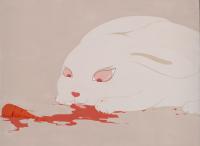 The scene is a gruesome one; a vicious creature with demonic red eyes and sharp claws eagerly laps at a gradually spreading pool of blood. Our gaze follows the trail of blood to the mangled corpse of a poor, defenseless carrot. Breathing a sigh of relief, the viewer quickly realizes that what was initially mistaken for blood is merely carrot juice and the bloodthirsty beast is just an albino bunny innocently enjoying its favorite snack. This mischievous visual duplicity typifies Lili's style and tiptoes playfully on the edge between lighthearted humor and foreboding dread. Her simultaneously cute and creepy animal subjects leave us questioning the difference and relationship between these two extremes.
The scene is a gruesome one; a vicious creature with demonic red eyes and sharp claws eagerly laps at a gradually spreading pool of blood. Our gaze follows the trail of blood to the mangled corpse of a poor, defenseless carrot. Breathing a sigh of relief, the viewer quickly realizes that what was initially mistaken for blood is merely carrot juice and the bloodthirsty beast is just an albino bunny innocently enjoying its favorite snack. This mischievous visual duplicity typifies Lili's style and tiptoes playfully on the edge between lighthearted humor and foreboding dread. Her simultaneously cute and creepy animal subjects leave us questioning the difference and relationship between these two extremes.
Click on the artwork for more information-
$35.00
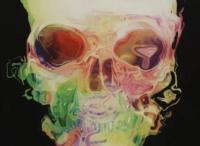 2009-07, is part of larger series based inspired by the the artist’s reflections on death. a large skull is centered on a black background. It is rendered frontally in a shimmering riot of colors, which gives it a psychedelic flavor. Despite its eerie qualities, its atypical, abstracted representation partially removes its deathly associations; the skull’s technicolor, viscous rendering dissolves its outline, which helps to conceal its true nature. However, its deep eye sockets create a vacuum that draws in its viewers, forcing them into a staring match that they cannot hope to win. This frontal depiction is a watery mirror for its audience, and a less than subtle reminder of the inevitability of mortality.
2009-07, is part of larger series based inspired by the the artist’s reflections on death. a large skull is centered on a black background. It is rendered frontally in a shimmering riot of colors, which gives it a psychedelic flavor. Despite its eerie qualities, its atypical, abstracted representation partially removes its deathly associations; the skull’s technicolor, viscous rendering dissolves its outline, which helps to conceal its true nature. However, its deep eye sockets create a vacuum that draws in its viewers, forcing them into a staring match that they cannot hope to win. This frontal depiction is a watery mirror for its audience, and a less than subtle reminder of the inevitability of mortality.
Click on the artwork for more information-
$35.00
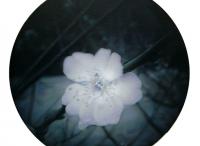 The fresh blossom in A Touch of Plum stands out against a desolate grey background of bare winter branches. While the other portraits Yang Xun's Flowers series all depict a supernatural light shining from the center of their subjects, this early bloomer appears woefully mortal. According to the artist, "The pale pink petals are tender and innocent, but in this desolate scene, seem to have bloomed in vain. This defiant but fragile blossom is bound to inspire hope for an early Spring." Yang’s Flowers series was inspired by Song dynasty flower paintings on round fans. With brilliant light and soft shadow, he uses his subjects to portray multisensory memories of attraction, hope, longing or despair.
The fresh blossom in A Touch of Plum stands out against a desolate grey background of bare winter branches. While the other portraits Yang Xun's Flowers series all depict a supernatural light shining from the center of their subjects, this early bloomer appears woefully mortal. According to the artist, "The pale pink petals are tender and innocent, but in this desolate scene, seem to have bloomed in vain. This defiant but fragile blossom is bound to inspire hope for an early Spring." Yang’s Flowers series was inspired by Song dynasty flower paintings on round fans. With brilliant light and soft shadow, he uses his subjects to portray multisensory memories of attraction, hope, longing or despair.
Click on the artwork for more information-
$35.00
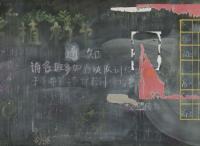 Do you remember your classroom blackboard? Chen Jiao takes us back to our first years of school: a glimpse into the world of language and letters, equations and charts. With layers of colorful accents, the childlike trees and found paper, she refers to her own childhood in southern China. The grey wash over the board mimics the grey sky of her industrial town; the trees evoke the trails where she discovered new pathways on long walks. The characters on the board remind the students of their post-Cultural Revolution identities as coexisting workers, yet the yellow chart creates a rating system for a spectrum of students. It is the paradox of Chinese education: how do you distinguish yourself when you must also live as one small part to a whole? No matter where you are from, Blackboard – Jintang Middle School, by Chen Jiao touches on the universalism of learning and its ability to shape both a society’s and child’s memories.
Do you remember your classroom blackboard? Chen Jiao takes us back to our first years of school: a glimpse into the world of language and letters, equations and charts. With layers of colorful accents, the childlike trees and found paper, she refers to her own childhood in southern China. The grey wash over the board mimics the grey sky of her industrial town; the trees evoke the trails where she discovered new pathways on long walks. The characters on the board remind the students of their post-Cultural Revolution identities as coexisting workers, yet the yellow chart creates a rating system for a spectrum of students. It is the paradox of Chinese education: how do you distinguish yourself when you must also live as one small part to a whole? No matter where you are from, Blackboard – Jintang Middle School, by Chen Jiao touches on the universalism of learning and its ability to shape both a society’s and child’s memories.
Click on the artwork for more information-
$35.00
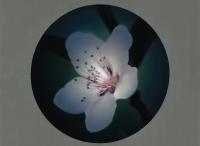 Yang Xun describes this portrait as “a peach blossom appearing from the dark like the scent of perfume left in the street; a visual sensation that reaches the viewer’s subconscious as a fragrance; a mood that gradually fills the air.” Yang’s Flower series was inspired by Song dynasty flower paintings on round fans. With brilliant light and soft shadow, he uses his subjects to portray multisensory memories of attraction, hope, pain, loneliness or despair.
Yang Xun describes this portrait as “a peach blossom appearing from the dark like the scent of perfume left in the street; a visual sensation that reaches the viewer’s subconscious as a fragrance; a mood that gradually fills the air.” Yang’s Flower series was inspired by Song dynasty flower paintings on round fans. With brilliant light and soft shadow, he uses his subjects to portray multisensory memories of attraction, hope, pain, loneliness or despair.
Click on the artwork for more information-
$35.00
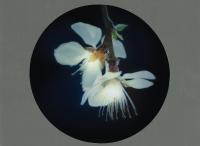 Flawless depicts two pear blossoms in full bloom, suspended from above, with supernatural light emanating from their centers. Yang Xun describes this portrait as “a memory of pure emotion, flawlessly white, but out of reach; where beauty offers hope to soften the pain of longing.” Yang’s Flower series was inspired by Song dynasty flower paintings on round fans. With brilliant light and soft shadow, he uses his subjects to portray multisensory memories of attraction, hope, loneliness or despair.
Flawless depicts two pear blossoms in full bloom, suspended from above, with supernatural light emanating from their centers. Yang Xun describes this portrait as “a memory of pure emotion, flawlessly white, but out of reach; where beauty offers hope to soften the pain of longing.” Yang’s Flower series was inspired by Song dynasty flower paintings on round fans. With brilliant light and soft shadow, he uses his subjects to portray multisensory memories of attraction, hope, loneliness or despair.
Click on the artwork for more information-
$35.00
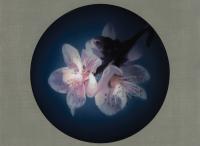 Chills on a Rainy Night depicts a cluster of pink blossoms against a nighttime backdrop. While the sky appears cold and overcast, a warm and unnatural light emanates from the pistil of the upward facing flower. Yang Xun describes this work as “the melancholy sight of peach blossoms on a rainy night, when long-forgotten memories can trigger a longing for someone who has disappeared from one’s life.” Yang’s Flowers series was inspired by Song dynasty flower paintings on round fans. With brilliant light and soft shadow, he uses his subjects to portray multisensory memories of attraction, hope, longing or despair.
Chills on a Rainy Night depicts a cluster of pink blossoms against a nighttime backdrop. While the sky appears cold and overcast, a warm and unnatural light emanates from the pistil of the upward facing flower. Yang Xun describes this work as “the melancholy sight of peach blossoms on a rainy night, when long-forgotten memories can trigger a longing for someone who has disappeared from one’s life.” Yang’s Flowers series was inspired by Song dynasty flower paintings on round fans. With brilliant light and soft shadow, he uses his subjects to portray multisensory memories of attraction, hope, longing or despair.
Click on the artwork for more information-
Available Soon
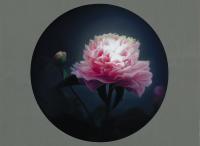 Note: This artwork is not yet available for sale, but will be soon.
Note: This artwork is not yet available for sale, but will be soon.
The Compendium of Materia Medica refers to a 16th-century compendium of medicinal herbs, compiled by Li Shizhen, a Ming Dynasty botanist and pharmacologist. According to the Yang Xun, "Peony was described in the Compendium of Materia Medica as an unambiguously beneficial herb. This medicinal aspect is overlooked because of its exquisite flower; but underneath the ostentatious petals is a staid and reliable character."
Yang’s Flowers series was inspired by Song dynasty flower paintings on round fans. With brilliant light and soft shadow, he uses his subjects to portray multisensory memories of attraction, hope, longing or despair.
Click on the artwork for more information-
$35.00








